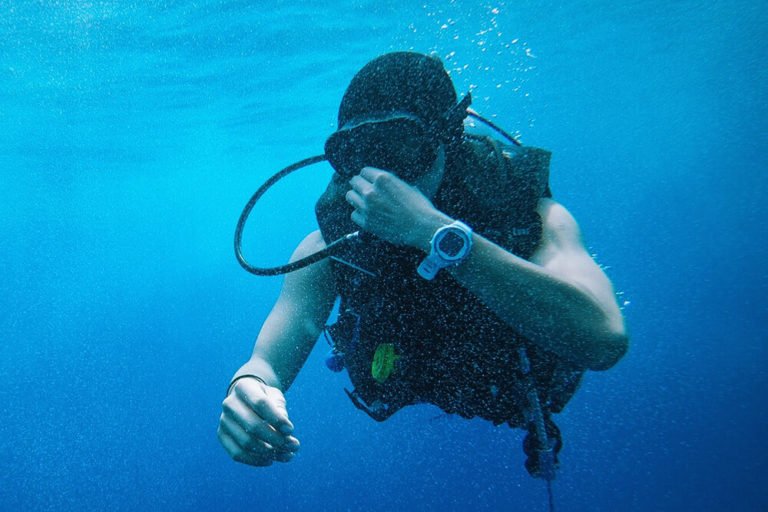Tips for Divers That Have Trouble Equalizing

Equalization is an important part of scuba diving. As you descend further into the water, the pressure on your outer ear will increase – and you need to increase the pressure in your middle ear to match the pressure of the outer environment. Otherwise, you could suffer “middle ear barotrauma,” which can damage blood vessels and nerves in your ear.
The most common way to equalize pressure in your ears is with the “Valsalva maneuver.” All you will do is pinch your nose shut or close your nostrils against your mask skirt. Then, blow through your nose.
This opens up the “Eustachian tubes” that connect your middle ear to the back of your throat. In turn, this allows the pressure between your outer, inner and middle ear to equalize, preventing any damage or pain to your ears.
Some divers have an easier time equalizing than others. Even experienced divers may have sensitive ears and have difficulty equalizing properly. If you are having equalization issues, there are some additional steps you can take to make equalization easier. Let’s take a look at them now.
1. GO SLOW DURING YOUR INITIAL DESCENT
If your ears are highly sensitive, it’s a good idea to make your initial descent into the water very slowly. This may not seem important, but it really is. Even just 1 foot below the surface of the water, your eardrums will experience pressure that is around 0.445 PSI higher than the atmosphere.
Descend to just 4 feet below the surface, and this increases to 1.78 PSI, which is enough to cause you some discomfort if you have not already cleared your ears and equalized pressure using the Valsalva maneuver.
If you find that your ears are particularly sensitive, you should descend very slowly. The standard advice is to equalize once for every 2 feet that you descend. If you find that your ears are very sensitive, you may want to do this every 1 foot.
2. EQUALIZE EARLY & OFTEN
Experienced scuba divers equalize continuously as they descend, and even when they’re just swimming at a normal depth in the water. You should make it a habit to equalize early and often when descending, and continue doing so until it’s nearly second-nature.
It may be that your ears are not extremely sensitive, but you are just forgetting to equalize regularly. Even descending 4-6 feet without equalizing can cause serious pressure and discomfort to build within your ears.
3. START EQUALIZING BEFORE YOUR DIVE
It can be helpful to get into the habit of equalizing your ears before you even start scuba diving. This can help reduce the chances of a block early on in your descent and helps you become more familiar with the process of equalization.
For a similar effect, you can also chew gum between dives. Chewing gum forces you to swallow regularly, which helps equalize pressure in your ears, and prevents further blockages between dives.
4. DESCEND FEET-FIRST
Air rises in your Eustachian tubes, while mucus is more fluid-like and tends to drain downward. This means that utilizing an equalization method like the Valsalva maneuver is easier if you’re in a “head-up” position rather than a “head-down” position. Consider making your descent feet-first to assist with clearing your ears.
5. LOOK UP WHEN EQUALIZING
For most people, extending the neck will help open up the Eustachian tubes, which makes it easier to equalize the pressure in your middle ear.
You may also find that tensing your throat and pushing your jaw forward and down will also help open up the Eustachian tubes, as these muscles help pull them open and enhance the efficiency of your Valsalva maneuver.
6. STOP IF IT HURTS
If you try to equalize your ears and you feel pain, you should stop right away. If you are too deep, your Eustachian tubes will be “locked” by the high-pressure differential, making proper equalization impossible.
If your ears hurt while you try to equalize them, you should ascend a few feet and try equalizing again. Continue ascending and attempting to equalize your ears until you are successful – and then begin descending again, and ensure that you equalize every 1-2 feet.
7. TRY THE “LOWRY TECHNIQUE”
For some people, the Valsalva maneuver is not enough to properly clear the ears. In this case, the “Lowry technique” may be a good option. This combines the Valsalva maneuver with the Toynbee maneuver, which involves pinching your nose and swallowing.
Basically, you will pinch your nose, then you will blow and swallow at the same time. You may want to practice this on land a few times, as it can feel awkward at first. But by combining the Valsalva maneuver and Toynbee maneuver, you will likely be much more successful at equalizing your ears.
8. UNDERSTAND OTHER FACTORS THAT CAN CONTRIBUTE TO EQUALIZATION ISSUES
There are some other problems that can contribute to difficulty equalizing your ears. Depending on your situation, some of these may apply to you.
- Having a cold or upper respiratory infection can cause the buildup of excessive congestion, making it extremely difficult to clear your ears. We recommend skipping your dive if you’re sick.
- Smoking cigarettes and using certain types of drugs can make it harder to equalize your ears.
- Dehydration causes your Eustachian tubes to be more “sticky” and prone to locking up, which can make it hard to clear your ears. Make sure you’re properly hydrated before your dive.
- Dairy consumption can increase mucus production, so some divers skip dairy a few days before a dive to help make it easier to equalize the ears.
USE THESE TIPS TO HELP WITH PROPER EQUALIZATION
Whether you’re taking a beginner course or you’re an experienced scuba diver, these tips are sure to help you equalize your ears properly – and stay comfortable while you dive. For more tips and information about proper equalization, we recommend speaking with your scuba diving instructor.
